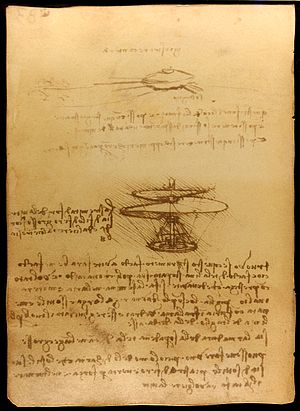Air screw (Leonardo da Vinci)

|
| Paris Manuscript B, folio 83v |
|---|
| Leonardo da Vinci , around 1487–1490 |
| Pen and ink on paper |
| approx. 23 x 16 cm |
| Institut de France, Paris |
The propeller is an aircraft sketched by Leonardo da Vinci around 1487 to 1490 in the so-called Paris manuscripts ( Manuscript B , Folio 83v). The original manuscript is now in the holdings of the Institut de France in Paris .
Leonardo da Vinci called his invention "Helix Pteron" (from the Greek έλιξ, helix = helix, and pteron = wing). It already applies the principles of the helicopter .
The principle of helical buoyancy was already known to the Chinese before Leonardo, who had already used it 2,500 years ago in the “flying top” toy.
construction
A round pole stands in the middle of a circular platform. It is supported on three sides by inclined beams made of reed wood , at the top of which there is a round wood with a round hole in the middle for the pole. The spiral made of linen , with a diameter of around five meters, is connected by iron wires to a ring that rotates around the platform. The screw is driven by four people standing on the platform who walk in a circle.
Functionality
Leonardo's invention could not be realized because it lacked a suitably light, stable material and a strong drive that was powerful enough to lift large masses into the air. It would be another 450 years before the first real helicopter was developed. However, a partial aspect of the principle of buoyancy was discovered.
His sentence was correct: “If this instrument is well made in screw form, ie made of linen cloth and its pores clogged with paste, and if you get it to spin quickly, it turns out that this screw is in the air as a wing acts and rises very high. "
- Models of the propeller
Model in the Museo nazionale della scienza e della tecnologia , Milan
Model of the propeller in the helicopter museum in Bückeburg
Model of a propeller in Clos Lucé Castle , France
Web links
Individual evidence
- ^ J. Gordon Leishman: Principles of Helicopter Aerodynamics . Cambridge University Press, Cambridge NY 2006, p. 9, ISBN 0-521-85860-7




